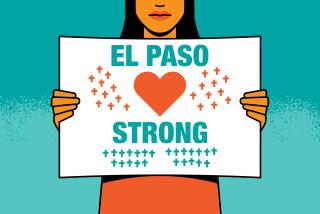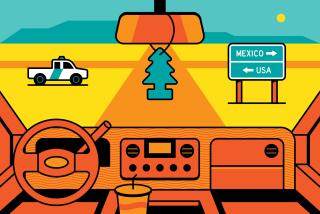How am I driving? In Mexico City, like a jerk
- Share via
MEXICO CITY — Two or three mornings a week, I get the day started with a shot of adrenaline and vehicular aggression coursing through my veins.
Who needs caffeine when you have vintage Volkswagens coming at you the wrong way?
Cement trucks running red lights, unlicensed bus drivers and traffic circles where a Darwinian, survival-of-the-rudest logic prevails: I fight them all just to get my daughter to preschool, a harrowing drive of 1.3 miles.
Last year, more new cars were sold in Mexico than ever before: 1.2 million. In Mexico City, my minivan is one of about 6 million cars, taxis, buses and other vehicles, carrying 29 million people, that hit the streets every day.
The city traffic grid, first laid out by the Aztecs, is a patched-together series of compromises with Mexico City’s tumultuous history. By every measure, traffic is worse here than it’s ever been, despite the heroic efforts of a small cadre of traffic engineers who struggle to keep things moving.
“Everyone wants to be in the same place at the same time,” says Alejandro Hernandez Garcia, the official in charge of monitoring the grid. “People don’t respect the traffic signs. They don’t respect the traffic lights, either, especially at night.”
The average Mexico City resident commutes nearly four hours each day. A recent and disturbing phenomenon has people commuting to Mexico City from the city of Puebla, 90 miles and three hours away.
Traffic is so bad here, and driver behavior so out of control, that city officials are considering reinstating driving tests. Draconian fines soon will be implemented against such everyday sins as going the wrong way on a one-way street.
It’s the huge numbers and the lack of space that force everyone who drives here to routinely be a jerk -- this scribe no exception. My fellow drivers and I double-park, we cut each other off, we make right turns from the left lane.
The locals rarely complain. There is no phrase in Mexican Spanish equivalent to “road rage.”
To drive in Mexico City, I’ve had to forget almost everything I learned in California.
Slowly, I’m learning how to drive like a chilango -- that’s what residents of Mexico City call themselves.
To drive in this city you must be at once aggressive and patient. You ease your car into the next lane and force other drivers to let you in, because otherwise you’ll never get where you’re going. When someone cuts you off, you just let it go.
You must learn to surrender yourself to the traffic gods, who are, on most days, exceedingly angry with us poor sinners down here in the Valley of Mexico.
“At the beginning, you fight it, you’re angry with everybody. But if you have that attitude, you don’t last,” says Elias Nunez, a veteran taxi driver in the Polanco neighborhood who drives me home one day. (In an effort to preserve my sanity, I don’t drive to work.)
“Sometimes, the traffic gets like this,” Nunez says, taking his two hands and weaving his fingers together. “And no one can move.”
Ah, yes, I say. We have a word for that in English: gridlock.
It’s another one of those Americanisms I think is untranslatable, until I meet Alfredo Hernandez Garcia.
A complicated problem
Hernandez Garcia is the man in charge of preventing carros atrapados, or trapped cars. He works in a bunker-like office in a nondescript building of the Public Security Secretariat, Mexico City’s police force.
A graduate of the country’s only university program in traffic engineering, he is a man uniquely prepared for a job best described as mitigating failure.
“It gets complex, very complicated,” he says. It’s a word he uses a lot to describe the traffic: complicado.
As he talks, he looks distractedly at a live screen image transmitted by one of 300 cameras trained on traffic. This one shows his biggest headache, the “Periferico,” or Peripheral Highway, which circles the city, although it long ago was encircled by more city. At 1:42 p.m., four hours before rush hour, traffic on the Peri has come to a halt.
“It’s totally paralyzed,” I observe, pointing at the screen. “Those cars are trapped.”
“Yes,” he says with a frown. He gets on the phone and a short while later tells me, “A truck got stuck. We’ve sent a tow truck to clear it.”
It isn’t just broken-down cars that make the traffic complicado, he says. People deliberately try to tangle things up. Several times a month one protest or another blocks a key artery, upsetting the delicate balance that keeps traffic bearable, but still bad.
Last year, Hernandez Garcia says, a single political protest caused a backup involving half a million vehicles.
He attacked the problem with helicopters, tow trucks, traffic cops on motorcycles and computer-controlled traffic signals. He got into a helicopter himself, commanding his troops from the sky.
“It took us three hours to sort that one out,” Hernandez Garcia says. “That was a hard day.”
The Mexico City government is preparing to increase the fines imposed on all those bad drivers I see in my neighborhood, he tells me. The Volkswagen driver who played chicken with me the other day could soon face a fine of $850 for driving the wrong way.
City traffic cops issue 6,000 citations every day. More than half are for double-parking.
People park on the sidewalks, Hernandez Garcia says, which forces pedestrians to walk in traffic. Even though the city’s notoriously slow traffic mitigates the danger, on average 1,500 drivers and pedestrians are killed in accidents in Mexico City each year, a rate significantly higher than that in Los Angeles County.
Once, driving tests were required, but they were scrapped because so many people paid bribes to get their licenses. Now the city is drawing up proposals to reinstate the tests. In the meantime, the city has launched a program to educate schoolchildren about traffic laws, Hernandez Garcia says.
Presumably, all those children will become backseat traffic cops, yelling out things like, “Daddy, you just went through a red light!”
Speed bump mania
Widespread disregard for traffic laws here has led to a citizen backlash.
Neighborhood groups have filled the city with speed bumps, many of them built without official permission. Some are so high the locals call them “mountains.”
Sergio Anibal Martinez, the newly appointed director of traffic planning for Mexico City, estimates the capital has 10,000 speed bumps, most them illegal. On average, a Mexico City driver encounters a bump every 950 yards of pavement.
“They really are a nuisance,” Martinez says. They make the pollution worse, because engines operate less efficiently when forced to slow down and rev up again, he says. “But people want them because they think it makes things safer.”
Martinez has plans to make traffic flow better. None involves more roads. The previous administration, led by Mayor Andres Manuel Lopez Obrador, built a second level for part of the Periferico, but the cost was so high that it contributed to his defeat in last year’s presidential race.
“We don’t intend to make our city like Houston, Dallas or Los Angeles, a city filled with freeways,” Martinez says.
Mexico City will never tear down entire neighborhoods, as Los Angeles did decades ago.
“We’re carrying this cultural burden of our past, which is still present,” Martinez says.
So the Peripheral Highway curves sharply around one 17th century church near my home. People who enter Mexico City from the main highway to the north are summarily dumped onto what is said to be the longest continuous street on the planet: Avenida Insurgentes. When the highways opened in the mid-20th century, there was simply no room for Los Angeles-style onramps and offramps.
“The city grew in a contradictory manner, and people built things just thinking of the needs of the moment,” Martinez says. “They thought Avenida Insurgentes would be able to handle all the traffic coming in from the north.”
Still, Martinez thinks Mexico City is no different from other places he’s visited. “All megalopolises are like this,” he says.
The other day he visited his relatives in Los Angeles. He was surprised to discover that they eat breakfast in their cars. He raises his eyebrows in disapproval -- no one ever does that in Mexico City.
Much later, the explanation occurs to me: It’s impossible to eat in your car in Mexico City. There are too many speed bumps.
What if I just ...
I guide my car over five speed bumps and past two traffic signals on the way to my daughter’s preschool.
There are a few stop signs, too, but everyone rolls past them, as though they had been put up in the era of the horse and buggy and don’t apply to the 21st century.
The other day I stopped at one. Why not, I thought. Old habits die hard.
Honk! Honk! Honk! I looked in my rear-view mirror at a growing line of cars behind me. Go! Go! Just go! their horns shouted.
But I can’t, I pantomimed back. Look, it’s a red octagon, the universal symbol for stop.
Honk! Honk! Honk!
So I did what any self-respecting chilango does several times each day: I simply plunged forward.
*
More to Read
Sign up for Essential California
The most important California stories and recommendations in your inbox every morning.
You may occasionally receive promotional content from the Los Angeles Times.











